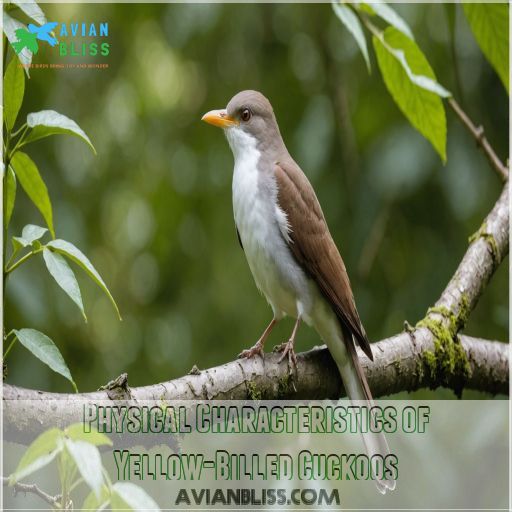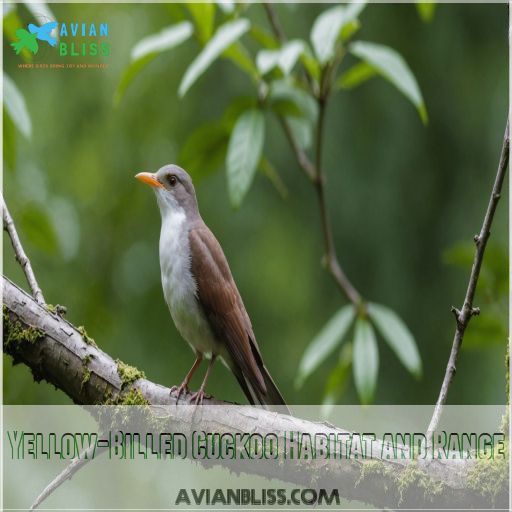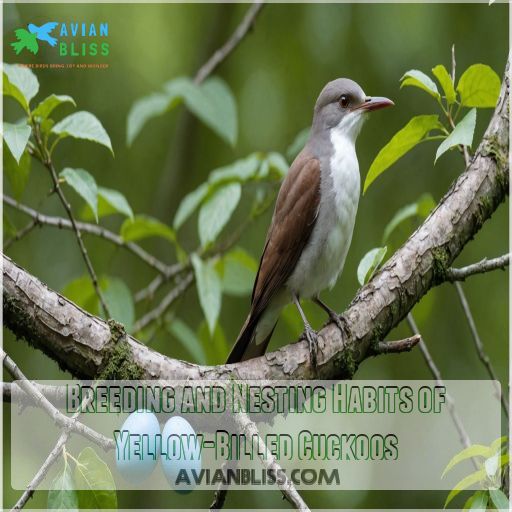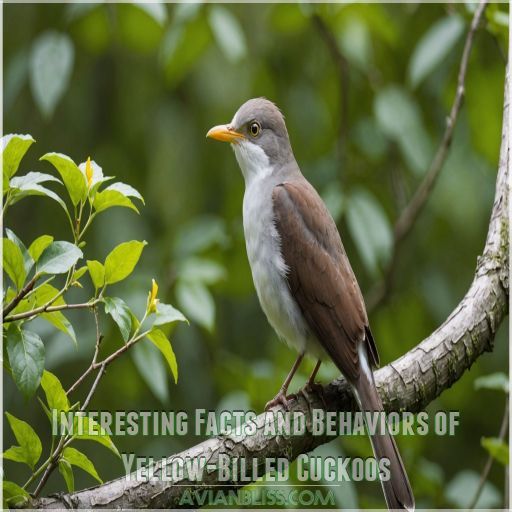This site is supported by our readers. We may earn a commission, at no cost to you, if you purchase through links.

This slender, long-tailed creature sports a warm brown coat up top and crisp white undies, with a bill that’s as yellow as a ripe banana.
They’re the ninjas of the forest, silently gliding through dense woods and riparian areas.
These bug-busting machines devour caterpillars like there’s no tomorrow, helping keep your local ecosystem in check.
Their "kowlp" call might sound like a drunk woodblock, but it’s music to nature lovers’ ears.
Stick around to uncover the cuckoo’s secret life – it’s wilder than you’d think!
Table Of Contents
- Key Takeaways
- Physical Characteristics of Yellow-Billed Cuckoos
- Yellow-Billed Cuckoo Habitat and Range
- Diet and Foraging Behavior of Yellow-Billed Cuckoos
- Breeding and Nesting Habits of Yellow-Billed Cuckoos
- Vocalizations and Communication of Yellow-Billed Cuckoos
- Conservation Status and Threats to Yellow-Billed Cuckoos
- Interesting Facts and Behaviors of Yellow-Billed Cuckoos
- Protecting and Preserving Yellow-Billed Cuckoo Populations
- Frequently Asked Questions (FAQs)
- Are yellow billed cuckoos secretive?
- What is a yellow billed cuckoo?
- Are yellow billed cuckoos rare?
- Do yellow billed cuckoos parasitize other birds?
- How rare are Yellow-Billed Cuckoos?
- What are the predators of Yellow-Billed Cuckoos?
- Are Yellow-Billed Cuckoos parasites?
- Why are Yellow-Billed Cuckoos threatened?
- How long do yellow-billed cuckoos typically live?
- Do yellow-billed cuckoos form flocks?
- What are their main predators?
- How fast can yellow-billed cuckoos fly?
- Do yellow-billed cuckoos return to the same nesting sites?
- Conclusion
Key Takeaways
- You’ll be amazed by the yellow-billed cuckoo’s ninja-like skills in the forest. These slender birds with banana-yellow bills are masters of camouflage, silently gliding through dense foliage like feathered secret agents.
- They’re nature’s pest control superheroes, gobbling up thousands of caterpillars each season, just like birds that control garden pests
. It’s like they’re hosting an all-you-can-eat buffet for themselves while keeping your local ecosystem in balance.
- You might hear their distinctive "kowlp" call before you spot them. It sounds a bit like a drunk woodblock, but don’t be fooled – these calls are crucial for everything from wooing mates to warning about incoming storms.
- While they’re still common in the East, yellow-billed cuckoos are becoming rare sights in the West due to habitat loss. By protecting riparian areas, you can help ensure these fascinating birds don’t become just another bedtime story for future generations.
Physical Characteristics of Yellow-Billed Cuckoos
You’ll be amazed by the distinctive features of the yellow-billed cuckoo.
With its long, slim body, bright yellow bill, and striking black face mask, this bird is truly a sight to behold.
Get ready to spot its rusty red wings and white-spotted tail as it flits through the dense foliage.
Body Size and Shape
Regarding the physical characteristics of the yellow-billed cuckoo, or Coccyzus americanus, envision a sleek bird measuring 11 to 13 inches in length.
Its wingspan, reaching about 15 to 16 inches, complements a long tail for graceful flights.
With a modest body weight of 40 to 65 grams, its head size and bill shape are distinctive yet understated.
Plumage Color and Pattern
As you admire the yellow-billed cuckoo’s elegant body, notice its wondrous plumage.
This bird’s feathers showcase rich brown wings with rusty patches and crisp white underparts.
Its tail flaunts striking white spots against a black backdrop, creating a perfect camouflage role in dense foliage, much like that of other small black and white birds
.
With plumage variation, these structural colors illustrate a remarkable evolution throughout the cuckoo’s life cycle (Source).
Bill Color and Length
Imagine spotting a yellow-billed cuckoo: its bill is a marvel of nature!
The bill sports a bright yellow lower side, evolving to enhance its bug-catching prowess, particularly spongy moth caterpillars.
This bill’s length and curve are uniquely functional.
Climate change influences such elegant adaptations, while these common birds face steep declines, urging attention from Partners in Flight.
Facial Markings
Spotting a Yellow-Billed Cuckoo’s facial markings feels like nature’s game of hide and seek.
They sport subtle eye-ring variations and a faint black mask, both essential for camouflage and identifying individuals.
These markings evolved to help them sneak up on gypsy moths unnoticed. Fascinating, isn’t it?
Each bird’s unique markings add flair to their secretive forest life.
Wing and Tail Characteristics
After appreciating the facial markings, let’s consider the Yellow-billed Cuckoo’s wings and tail.
These birds flaunt a wingspan of 13.4 to 15.8 inches, with feathers tinted rufous.
Their tails boast striking white and black patterns, resembling six large white spots.
When in flight, their graceful pattern captivates, making these secretive birds a joy to observe.
Juvenile Characteristics
Young yellow-billed cuckoos display plumage that’s less vibrant than adults but still charming!
You’ll notice:
- Juvenile plumage: Cinnamon brown wing coverts, somewhat similar to the distinctive patterns found in small yellow birds such as the American Goldfinch, which features bright yellow plumage.
- Bill development: Less yellow on the bill than adults.
- Fledgling behavior: Curious and exploratory, often foraging for diverse food sources like seeds, nectar, insects, and fruits that small yellow birds typically eat small yellow birds.
- Parental care: Parents tirelessly nurture their growth stages, guided by nature’s manual.
Remember, every bird was a fledgling once—awkward yet spirited!
Yellow-Billed Cuckoo Habitat and Range
You’ll find yellow-billed cuckoos in a variety of wooded habitats, from dense thickets along streams to overgrown orchards.
These birds roam far and wide, with some even making the long journey to Argentina for the winter.
Preferred Wooded Habitats
With their sleek bodies and striking bills, Yellow-Billed Cuckoos prefer habitats with dense riparian zones and lush forest structures. Picture them nestled in overgrown orchards or abandoned farmlands, evading habitat loss and invasive species.
Conservation efforts are key here. They remind us of neighbors, always seeking the perfect backyard.
These birds are often found in areas with abundant native wildflowers, providing them with a natural food source. These areas provide important habitat for many yellow bird species.
| Habitat Type | Key Feature | Threat |
|---|---|---|
| Riparian zones | Dense foliage | Habitat loss |
| Overgrown orchards | Thick cover | Invasive species |
| Abandoned farmlands | Water sources | Development |
Types of Vegetation and Landscapes
Picture the yellow-billed cuckoo nestled in riparian areas and forest edges, where dense vegetation thrives.
These birds avoid landscapes taken over by invasive species.
They flourish where habitat restoration efforts counteract climate change impacts, creating a lush environment just perfect for nesting.
It’s like choosing a well-tended backyard over a barren concrete jungle for a peaceful retreat.
Regional Variations in Habitat
You’ve got the cuckoo settling comfortably into diverse regions.
In the West, it favors streamside willow groves, offering a cozy nest site.
In contrast, Eastern cuckoos enjoy dense deciduous forests, thriving on abundant food sources.
These regional adaptations highlight their flexibility but also expose threats like habitat loss, essential for their survival and prompting our attention.
Migration Patterns and Wintering Grounds
If you’ve just explored regional habitats, consider the Yellow-Billed Cuckoo’s epic journey. This master of travel follows migration routes to its wintering habitat in South America.
During transit, these birds face threats like collisions with towers. Seasonal variations in their breeding grounds influence their leave.
Here’s a quick guide:
- Long-distance migrations
- Nocturnal travel
- Collision risks
- Climate impacts
Geographic Distribution Across North America
Where do Yellow-Billed Cuckoos call home in North America?
You’ll find them inhabiting dense woodlands and riparian areas, stretching from the lush eastern forests to the dwindling western streamside groves.
Migration routes take them southward as they escape cold winters, yet habitat changes threaten their population density.
Conservation efforts are essential to preserve these unique birds, emphasizing the need for conservation efforts.
Diet and Foraging Behavior of Yellow-Billed Cuckoos
You might be surprised to learn that the yellow-billed cuckoo’s diet is largely centered around caterpillars, gobbling up thousands each season.
It doesn’t shy away from beetles, ants, and even the occasional frog, adapting its foraging habits to whatever tasty treats are in season.
Primary Food Sources
Cuckoos are caterpillar connoisseurs, gobbling up thousands per season.
They’ll glean insects from leaves or even hop to the ground to chase down lizards and grasshoppers.
During periodic caterpillar outbreaks, cuckoos may feast on 100 at a time. Their adaptations, like rolling caterpillars to strip off hairs, help them thrive on this protein-packed diet.
Supplemental Food Sources
Imagine this: yellow-billed cuckoos broadening their horizons beyond insects, nibbling on small frogs, lizards, and even bird eggs.
These supplemental options boost their diet when insect abundance dips.
Seasonal variation leads to diet overlap with other birds, spicing up competition dynamics.
They’re adaptable diners, enhancing foraging efficiency while avoiding the culinary rut.
Adventure is their middle name!
Foraging Techniques and Strategies
Imagine the Yellow-Billed Cuckoo honing its foraging finesse. You’ll find it mastering caterpillar hunting techniques, especially during insect outbreaks.
Consider its dynamic strategies:
- Leap and grab: Lunge for ground prey, like lizards.
- Swoop and pluck: Catch flying insects mid-air.
- Foliage gleaning: Find tasty morsels on leaves.
It’s a gourmet in the bird world, choosing prey with precision.
Adaptations for Finding and Eating Prey
As you explore the foraging world of Yellow-Billed Cuckoos, you’ll uncover their remarkable knack for detecting caterpillars.
They’re like nature’s bug detectives, scanning leaves with their keen eyes and specialized bill adaptations.
These cuckoos employ efficient foraging strategies, making the most of prey abundance.
Just imagine the satisfaction of a successful hunt with their highly tuned skills!.
Seasonal Variations in Diet
You just witnessed how Yellow-Billed Cuckoos adapt their diet like a chef with a seasonal menu.
During caterpillar abundance, they feast on these insects, taking advantage of insect outbreaks for a buffet of options.
When caterpillars are scarce, they embrace diet shifts, munching on small fruits and other prey based on food availability throughout the year.
Breeding and Nesting Habits of Yellow-Billed Cuckoos
When you’re looking at the breeding habits of yellow-billed cuckoos, you’ll find they aren’t the most conventional parents, often leaving eggs in others’ nests as if they’re sending their children to sleepovers.
Their nests are typically hidden in dense foliage, using sticks and grass, while both mom and dad take incubating the brood with the precision of a well-practiced relay team. Both parents participate in the process, demonstrating a unique parenting style in the bird world, showcasing a remarkable example of conventional parents.
Nest Placement and Location
Caterpillars are favorite snacks, but where to court them? Nest placement is key for yellow-billed cuckoos.
Consider these essentials:
- Nest site selection: Opt for trees like oaks or willows.
- Nest height: Range from 3 to 90 feet.
- Nest density: Favor areas with mixed willow and dogwood.
This method regularly enhances nest success.
Nest Description and Materials
Though the yellow-billed cuckoo’s nest may look a bit haphazard, don’t be fooled – this bird’s craftsmanship is quite impressive!
The male and female work together to build a flat, oblong platform nest using twigs they collect from the ground or snap directly from nearby trees and shrubs.
They may line the nest with strips of bark or dried leaves, but the overall structure remains delightfully loose and airy. The nest’s appearance is a result of the male and female’s combined effort, showcasing their impressive craftsmanship.
Egg-Laying and Incubation
Imagine a yellow-billed cuckoo selecting its nest site with precision, almost like choosing the perfect spot for a new cafe.
Yellow-headed Blackbirds, for instance, thrive in similar freshwater marshes and open fields Yellow-headed Blackbirds’ Habitat and Range. Their expertise in foraging in nearby areas could provide valuable insights into the cuckoo’s nesting habits.
Egg size matters, with the tiny, pale bluish-green eggs incubating for just 9-11 days. Both parents play active roles, while occasionally facing challenges from brood parasitism.
It’s like a real-life drama in nature!
Parental Care and Chick-Rearing
Yellow-Billed Cuckoos have laid their smooth greenish eggs, and now the real work begins. These devoted parents put their hearts into chick-rearing.
You’ll see:
- Nestling development: Rapid feather growth within 24 hours.
- Brood size variation: Ranges from one to five hungry mouths.
- Feeding frequency: Who knew you’d become a caterpillar chef extraordinaire?
Brood Parasitism and Nesting Success
Just as you admire the devoted care of cuckoos for their chicks, you might wonder about brood parasitism’s role. Cuckoos occasionally exploit other bird nests, relying on host species. Factors like host response and nestling competition impact their success.
This strategy enhances adaptability in changing environments.
| Aspect | Effect | Host Impact |
|---|---|---|
| Brood Parasitism | Increases adaptability | Raises competition |
| Host Response | Affects success | Decreases brood size |
| Nesting Success | Enhances survival | Reduces chicks’ success |
Vocalizations and Communication of Yellow-Billed Cuckoos
When you hear a yellow-billed cuckoo’s call, it might sound like a rapid, rattling dance that slows as it finishes.
These birds aren’t shy about using their voices, whether it’s the "Kowlp" to get a mate’s attention or a "Mew" to distract predators from their nests.
Types of Calls and Sounds
Imagine sitting in a leafy grove and hearing the diverse calls of the Yellow-Billed Cuckoo. Each call—from the rhythmic "Kowlp" to the percussive "Knocker" and plaintive "Mew"—sings a story.
These avian vocalizations inspired the Rain Crow myth, suggesting their cries summon rain—a whimsical belief touching both science and lore.
- Enchantment
- Curiosity
- Connection
- Serenity
- Wonder
Call Patterns and Structures
Ever heard the "rain crow"? That’s the yellow-billed cuckoo calling, using a rich tapestry of call variations and mimicry to communicate.
You’ll notice their calls differ with the seasons, creating unique acoustic cues.
It’s like nature’s own orchestra, playing tunes that are both ancient and adaptable. These vocalizations truly reflect their ever-changing world.
Functions of Different Calls
From their iconic "cow" call to softer chitters, yellow-billed cuckoos use a diverse vocal repertoire.
These calls serve multiple functions, like defending territory, attracting mates, and alerting others to predators.
You might even hear a begging chick’s raspy squawks as it pleads for more food.
These versatile vocalizations help cuckoos thrive in their woodland homes.
Vocalizations During Breeding and Courtship
With a call-and-response approach, Yellow-billed Cuckoos woo partners during breeding. Their duet variations are key in courtship, often amusingly likened to teenagers whispering secrets.
Vocalizations include:
- Mating rituals: charming calls to impress.
- Territorial defense: assertive trills to protect nests.
- Maximizing nesting success: harmonious songs shared by pairs.
- A sense of belonging, creating a soundscape of unity.
Geographic Variations in Vocalizations
Picture yourself listening to Yellow-Billed Cuckoos across their range, and you’ll notice remarkable dialectal differences.
These regional call variations reflect their geographic vocal patterns and adapt to different habitats.
Like a bird version of accents, their call diversity by range serves as nature’s way of crafting local tunes, adding a feather of humor to the bird’s delightful repertoire.
Conservation Status and Threats to Yellow-Billed Cuckoos
You’re probably concerned about the yellow-billed cuckoo’s shrinking numbers.
Largely due to habitat loss, collisions with structures, and climate shifts.
It’s essential to focus on conservation efforts to make sure this species doesn’t fade out of our skies permanently, especially considering the importance of Eastern Bluebirds to North Carolina’s ecosystems. Eastern Bluebirds in North Carolina
.
Population Trends and Declines
You might’ve heard their distinct calls echoing through the trees, but did you know yellow-billed cuckoos face declining numbers?
Population estimates show concerning trends, driven by habitat loss and climate change.
Pesticide use adds to the challenges they face.
Luckily, conservation efforts aim to reverse these declines and secure a brighter future for these fascinating birds.
Habitat Loss and Fragmentation
Imagine the bustling riverrine habitats shrinking, and you’ll see why habitat loss is no joke for the Yellow-Billed Cuckoo.
This feathered friend faces fragmentation impacts as riparian woodlands turn into farmland and housing.
Use riparian restoration and habitat connectivity as conservation strategies to reverse land use change.
These steps could reconnect this bird’s world.
Collisions With Human-Made Structures
Collisions with human-made structures profoundly impact Yellow-Billed Cuckoos.
During migrations, they frequently collide with wind turbines and buildings, leading to significant mortality.
It’s a sticky wicket, isn’t it?
By raising public awareness and implementing smart building design strategies, you can help mitigate these risks and safeguard the cuckoos’ journeys.
Ensuring their songs echo for generations .
Climate Change Impacts
The shifting riparian habitats and erratic insect emergence due to climate change pose grave threats to the yellow-billed cuckoo.
Breeding range contractions, delayed migration timing, and declining food sources jeopardize their survival.
Yet, there’s hope – community efforts and scientific models provide a path forward to protect this remarkable bird.
Audubon’s Western Yellow-billed Cuckoo (YBCU) biologists’ observations.
Conservation Efforts and Strategies
To safeguard yellow-billed cuckoos, get involved in riparian restoration, enhancing habitat connectivity and curbing those pesky pesticides.
You hold the power by supporting climate change mitigation efforts.
Embrace citizen science—it’s your chance to play detective and track these elusive birds.
Together, let’s make sure their symphony of calls adorns our wild places for generations to come.
Interesting Facts and Behaviors of Yellow-Billed Cuckoos
You might be surprised to learn that yellow-billed cuckoos travel thousands of miles each year and are so good at staying hidden that they’re affectionately called "rain crows" for their weather-predicting calls.
Their quirky habit of gobbling up caterpillars by the dozen helps keep pesky insect populations in check, making these birds fascinating neighbors in our ecosystems.
Unique Characteristics and Traits
Amidst habitat challenges, you’ll find that the Yellow-Billed Cuckoo boasts some remarkable characteristics.
Imagine a bird with:
- Zygodactyl feet for gripping branches.
- A knack for mimicry, fooling potential threats.
- The unique nickname "Rain Crow" due to its thunder-associated calls.
- Fascinating brood parasitism behavior, occasionally laying eggs in other birds’ bird nest relocation
.
Migration Patterns and Routes
You’ve explored their unique characteristics, and now discover yellow-billed cuckoos as sky travelers, setting off on epic journeys.
Timing their migration expertly, these birds take varied routes, soaring through bustling stopover locations.
They adapt to altitude changes while heading to wintering grounds, showcasing impressive athleticism.
It’s like their own avian road trip, without the snacks!
Social Behavior and Interactions
Migration guides yellow-billed cuckoos across vast distances, and once in their summer homes, their social behavior intrigues.
You might catch them pair bonding for life, crafting love nests with twig offerings.
These birds fiercely guard territories and nests, while engaging in brood parasitism to give their offspring a leg up.
These intriguing behaviors spark fascinating interspecies interactions and add a twist to their family dynamics.
Adaptations for Survival and Success
While social interactions keep Yellow-Billed Cuckoos connected, their true forte lies in adaptations.
Fancy some storytelling-worthy traits?
- Camouflage masters: Their brown and white plumage hides them in dense foliage.
- Foraging aces: Thousands of caterpillars meet their fate each season.
- Nesting ninjas: Building nests efficiently in safe spots, they help the next generation thrive.
These skills make survival a piece of cake!
Cultural Significance and Folklore
The yellow-billed cuckoo’s intriguing nicknames like "rain crow" and "storm crow" hint at its cultural significance.
Native myths often depict this bird as a harbinger of rain, a symbol of renewal, and a messenger between the human and natural worlds.
Its distinctive calls are part of the rich folklore and bird language cherished by many communities.
Protecting and Preserving Yellow-Billed Cuckoo Populations
Curious about the quirky behaviors of yellow-billed cuckoos? Equally fascinating is how you can help protect these amazing birds. Their well-being hinges on effective strategies like habitat restoration and conservation partnerships like those promoting integrated pest management
.
Imagine rolling up your sleeves with citizen science efforts—you get to be a hero for the environment from your own backyard! Conserving species like the Western Kingbird and other grey birds with yellow bellies, which showcase adaptability and resilience, also relies on preserving their natural habitats.
By protecting these birds and their habitats, we’re helping to maintain the balance of our ecosystem. Reducing pesticides is another critical step; it’s like removing harmful ingredients from your favorite recipe, just better for the birds and the planet. And while we’re at it, let’s not forget climate change mitigation.
Here’s how you can make a difference:
- Support local habitat restoration projects.
- Participate in citizen science initiatives.
- Advocate for pesticide reduction laws.
- Push for policies against climate change impacts.
Frequently Asked Questions (FAQs)
Are yellow billed cuckoos secretive?
You bet they’re secretive!
These elusive birds are masters of hide-and-seek, skulking in dense foliage.
Their shy nature makes spotting one feel like winning the lottery.
They’re the ninjas of the bird world, appearing and vanishing in a flash.
What is a yellow billed cuckoo?
Hiding in plain sight, this elusive bird’s a master of disguise.
You’ll hear its distinctive "ka-ka-ka" before spotting its slender form.
It’s a long-tailed forest dweller with a knack for caterpillar hunting and weather forecasting.
Are yellow billed cuckoos rare?
Rarity varies by region.
Once common, these elusive birds face challenges.
In the East, you’ll find them fairly often, but they’ve become scarce in the West due to habitat loss.
Their populations fluctuate with insect outbreaks.
Do yellow billed cuckoos parasitize other birds?
Surprisingly, only 1% of birds are brood parasites (Source).
Yellow-billed cuckoos occasionally play the nest-squatting game, laying eggs in other birds’ nests.
It’s nature’s version of finding a free babysitter, though they’re not serial offenders like some cuckoo cousins.
How rare are Yellow-Billed Cuckoos?
You’ll find Yellow-billed Cuckoos fairly common in the East, but they’re becoming a rare sight in the West.
With fewer than 500 pairs left in western states, these elusive "rain crows" are slipping away like shadows.
What are the predators of Yellow-Billed Cuckoos?
Hawks and falcons swoop in on adults, while sneaky snakes and small mammals raid nests.
Even sharks have been known to snag these birds.
Jays and grackles join the feast, making life a real balancing act for cuckoos.
Are Yellow-Billed Cuckoos parasites?
Nature’s opportunists play a surprising role.
These birds are facultative brood parasites, occasionally laying eggs in other nests.
They’re not full-time freeloaders, though.
They’ll build their own nests too, adapting to food availability and energy constraints. (Source)
Why are Yellow-Billed Cuckoos threatened?
Habitat loss is the main culprit.
These birds are losing their cozy riverside homes to farms and housing.
They’re also night flyers, making them sitting ducks for collisions with tall structures.
It’s a double whammy for these stealthy hunters.
How long do yellow-billed cuckoos typically live?
Picture a bird that’s outlived your favorite pair of jeans.
You’d be surprised – yellow-billed cuckoos can stick around for up to 4 years in the wild.
They’re not exactly long-lived, but they make every year count.
Do yellow-billed cuckoos form flocks?
You won’t find these birds hanging out in groups.
Yellow-billed cuckoos are loners at heart, preferring a solitary lifestyle.
They’re the strong, silent types of the bird world, flying solo through woodlands and thickets.
What are their main predators?
Keep your eyes peeled for nature’s hunters! Raptors like Aplomado falcons and red-shouldered hawks top the list.
Surprisingly, tiger sharks have a taste for these birds too.
Nestlings face threats from snakes, chipmunks, and even other birds.
How fast can yellow-billed cuckoos fly?
Precise flight speeds aren’t well-documented, but these birds are known for their graceful, gliding flight .
They’re agile enough to catch fast-moving prey like cicadas mid-air.
Their quick, fluid wingbeats help them navigate through dense foliage effortlessly.
Do yellow-billed cuckoos return to the same nesting sites?
Nesting habits of these elusive birds aren’t set in stone, particularly when it comes to nest building time
.
While they may revisit familiar spots, they’re adaptive and choose sites based on food and habitat conditions.
You’ll often find them in dense, leafy groves near water.
Conclusion
You’ve just scratched the surface of the yellow-billed cuckoo’s world! These stealthy forest dwellers are more than just pretty faces with banana-yellow bills.
They’re ecological superheroes, keeping caterpillar populations in check. But their secretive nature and dwindling habitats make them vulnerable.
By protecting riparian areas and learning to recognize their distinctive "kowlp" call, you can play a part in ensuring these fascinating birds continue to glide through our forests for generations to come.
Keep your ears open – you might just hear a cuckoo’s call and be a part of helping these fascinating birds.











